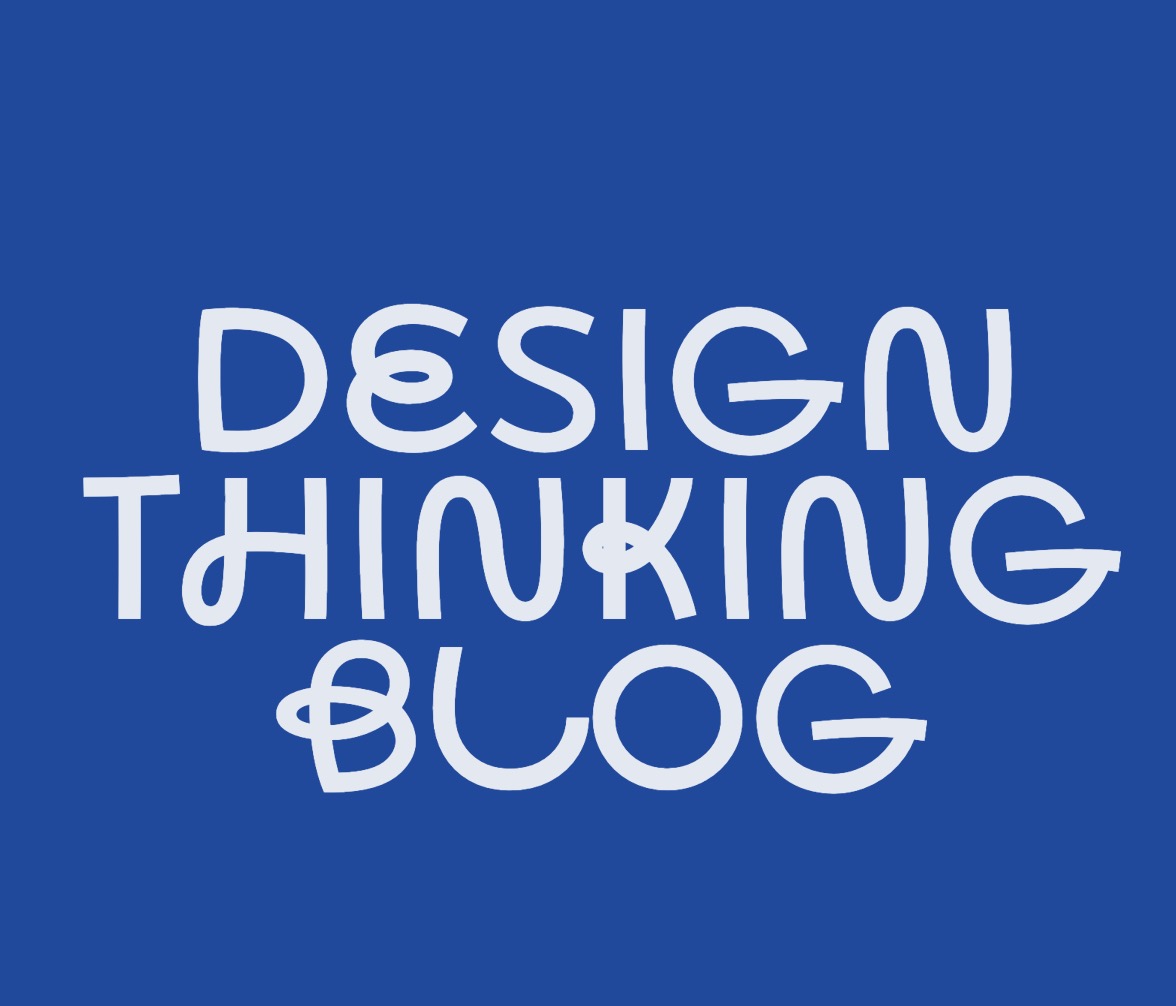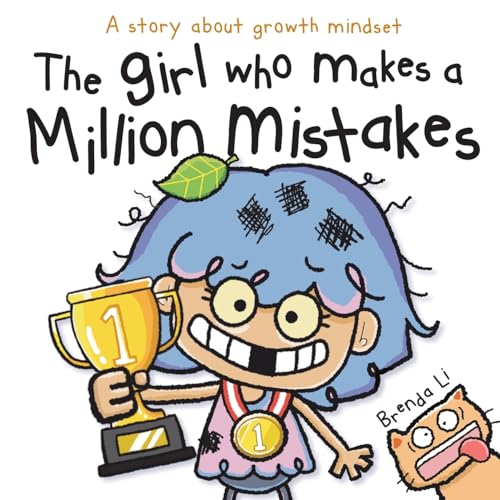Design Thinking
Design Thinking Leadership: Leading Innovation and Change!
Unleash the power of design thinking leadership to revolutionize innovation and drive change in your organization!
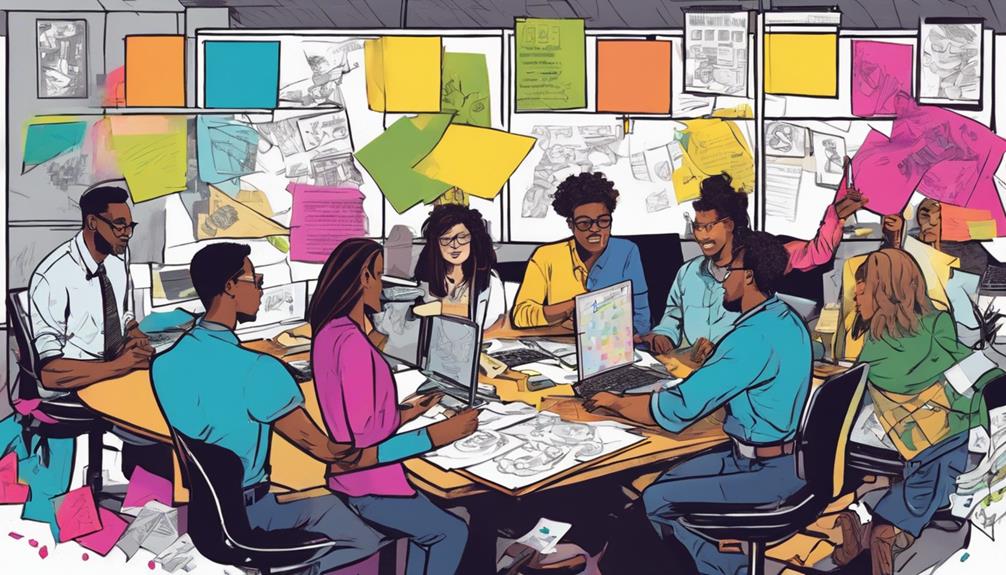
To guide innovation and change with design thinking, spark creativity, empower teams, and nurture a culture of innovation. Effective leadership is crucial to steering projects to success, fostering innovative thinking, and embodying design principles. Confront team dynamics, challenges, and emotional obstacles directly with strong leadership. Assist teams with transparent communication, resources, and a secure environment for ideas. Provide guidance, establish new idea environments, and embrace failure for continuous improvement. Design thinking in banking guarantees adaptability to market changes and customer-centric solutions. For a more in-depth exploration of design thinking leadership, delve into the strategies, benefits, and practical applications shared in the research.
Key Takeaways
- Foster a culture of creativity and innovation.
- Empower teams to drive change through design thinking.
- Lead by example in embracing new methodologies.
- Provide resources and support for innovative projects.
- Implement design thinking principles to inspire and guide teams.
Importance of Effective Leadership
Effective leadership plays an important role in guiding design-thinking projects to success. In the field of design thinking, leadership isn't just about giving orders but about inspiring and empowering teams to think innovatively and problem-solve creatively. Leadership in design thinking involves not only understanding the methodology but also embodying its principles of empathy, experimentation, and collaboration.
Leadership training is vital for senior executives to effectively enable and support design teams. These leaders need to champion a culture that embraces design thinking methods, even if they challenge traditional problem-solving approaches. They must foster an environment where iterative prototyping and testing are encouraged, promoting a mindset that sees failure as a stepping stone towards success.
For employees unfamiliar with design thinking, strong leadership is necessary to provide guidance and support. Leaders must lead by example, demonstrating a willingness to learn and adapt to new methodologies.
Challenges Faced by Project Teams

You may encounter challenges in project team dynamics, resistance, and managing emotional hurdles in design thinking initiatives.
Overcoming resistance to new methodologies and shedding preconceptions can be tough but important in this process.
Emotional flare-ups and uncertainties are common, so it's essential to navigate through them effectively for project success.
Project Team Dynamics
Moving through the challenges faced by project teams in design-thinking projects requires a deep understanding of team dynamics and potential hurdles that may arise.
In design-thinking projects, leadership processes play a pivotal role in addressing the wants and needs of team members. Employees accustomed to rationality and objectivity may find methods like empathizing with users challenging. Shedding preconceptions about products or services can be a struggle for team members engaging in design-thinking projects.
Anxieties arising from design-thinking findings have the potential to derail projects, leading to emotional flare-ups and uncertainties among team members. The iterative nature of prototyping and testing in design-thinking approaches may cause employees to feel like they're spinning wheels.
Effective leadership is essential in guiding project teams through these challenges, ensuring that team dynamics are managed effectively to drive innovation and change.
Overcoming Resistance
To overcome resistance in design-thinking project teams, addressing inherent challenges head-on is essential for progress and success. Design-thinking methods, such as empathizing with users, may initially appear subjective, posing a challenge for project teams accustomed to more concrete processes. Employees grappling with letting go of preconceptions about products or services can hinder the smooth flow of design-thinking projects.
The anxieties stemming from design-thinking findings have the potential to derail project progress if not managed effectively. Emotional flare-ups and uncertainties are common within design-thinking teams, requiring strong leadership to navigate through these turbulent waters. Additionally, the iterative nature of design-thinking approaches might give project teams the false impression of minimal progress, leading to frustration and resistance.
Managing Emotional Challenges
Managing emotional challenges in design-thinking projects demands a profound understanding of team dynamics and individual responses to the iterative and subjective nature of the process.
Teams can feel overwhelmed by the constant need to empathize with users, leading to anxiety and uncertainty.
Emotional flare-ups often arise during the prototyping and testing phases, impacting team morale and productivity.
Adapting to the unconventional approaches of design thinking can provoke frustrations and uncertainties, causing team members to feel like they're trapped in a cycle of intense emotions.
Recognizing and addressing these emotional challenges is essential for leaders to guarantee team cohesion and project success.
Leadership Strategies for Support

As you explore leadership strategies for supporting design thinking initiatives, consider the importance of adopting supportive approaches that foster creativity and innovation.
Providing guidance and mentorship to your team can help navigate the complexities of design thinking projects effectively.
Supportive Leadership Approaches
Supporting design thinking teams effectively requires leaders to create an environment that fosters innovation and collaboration. To achieve this, leaders should:
- Encourage Open Communication: Facilitate open discussions where team members feel comfortable sharing their ideas and perspectives without fear of judgment. This open communication fosters creativity and allows for the free flow of innovative concepts within the team.
- Provide Resources and Support: Leaders should guarantee that teams have access to the necessary resources, tools, and support needed to explore new ideas and concepts effectively. By supplying the right resources, leaders empower teams to turn their innovative ideas into actionable solutions.
- Promote Psychological Safety: Cultivate a culture where team members feel psychologically safe to take risks, experiment, and learn from failures. Psychological safety fosters creativity and risk-taking, which are essential elements of successful design thinking projects.
Guidance for Team Success
How can leaders effectively guide their teams towards success in design thinking projects?
To ensure your team thrives, create an environment that encourages the emergence of new ideas. Guide them through the various methodologies of design thinking, helping them navigate the process effectively. It's crucial to maintain a clear sense of direction and purpose throughout the project, keeping everyone focused on the end goal.
Support your team without stifling their creativity. Avoid micromanaging, as it can inhibit innovation. Instead, provide guidance and resources to empower them to explore new possibilities.
Embrace failure as a stepping stone to success, encouraging your team to learn from mistakes and iterate on their ideas. By fostering a culture that embraces experimentation and continuous improvement, you'll set your team up for success in design thinking initiatives.
Empowering Through Mentorship
To empower your team effectively through mentorship in design thinking leadership, focus on providing guidance and support as they navigate the complexities of the design process. Effective mentorship helps teams embrace failure, learn from iterative processes, and stay focused on the project's purpose.
Leaders empower teams by creating a conducive environment for new ideas to emerge and flourish. Mentorship encourages teams to navigate the challenges of design thinking and maintain a sense of direction. Guidance from leaders in design thinking projects is essential for teams to overcome uncertainties and emotional flare-ups.
Case Study: Crisis Management

During a design-thinking project focused on enhancing services, Anne Lind encountered a crisis that shifted perspectives towards prioritizing client needs over organizational efficiency.
The project unearthed a disconnect between organizational goals and client requirements, prompting a reevaluation of processes originally tailored to meet internal needs.
By immersing themselves in the experiences of clients, the project team realized the necessity of realigning services with client expectations.
This crisis underscored the crucial importance of ensuring that design-thinking projects are centered on meeting the needs and desires of the end-users.
It became evident that to drive successful innovation and change, organizations must prioritize understanding and addressing the concerns and preferences of their clients.
This shift in perspective not only transformed the direction of the project but also served as a valuable lesson in crisis management within the domain of design thinking, emphasizing the significance of aligning services with client expectations.
Benefits in Banking Sector

Design thinking in the banking sector plays a pivotal role in fostering an innovative ecosystem to adapt to evolving landscapes. Here are three key benefits of design thinking in the banking sector:
- Adaptation to Changing Landscapes:
Traditional industries like banking, facing regulatory reforms and financial crises, can benefit significantly from integrating design thinking approaches. This enables banks to stay agile and responsive to dynamic market conditions.
- Competitive Edge:
Banks, including industry giants like HSBC, have embraced design thinking to navigate challenges posed by new competitors and external shocks such as the global pandemic. This proactive approach helps them stay ahead of the curve in a rapidly evolving financial landscape.
- Customer-Centric Innovation:
Steve Suarez's Design Thinking Journey

Steve Suarez's journey into design thinking leadership at HSBC began with his role as the Global Head of Innovation, where he was dedicated to fostering a culture of creativity and problem-solving within the organization. To deepen his understanding, Suarez completed eight courses in Innovation and Entrepreneurship through Stanford Online. Subsequently, he developed a Design Thinking 101 course tailored for his colleagues at HSBC. This initiative proved successful, with over 5,500 individuals registering for the course. Due to Suarez's efforts, Design Thinking concepts were effectively introduced to the leadership at HSBC, marking a significant shift towards innovative practices within the company.
| Courses Completed | Platform | Institution |
|---|---|---|
| 8 | Stanford Online | Stanford |
Impact of Design Thinking Courses
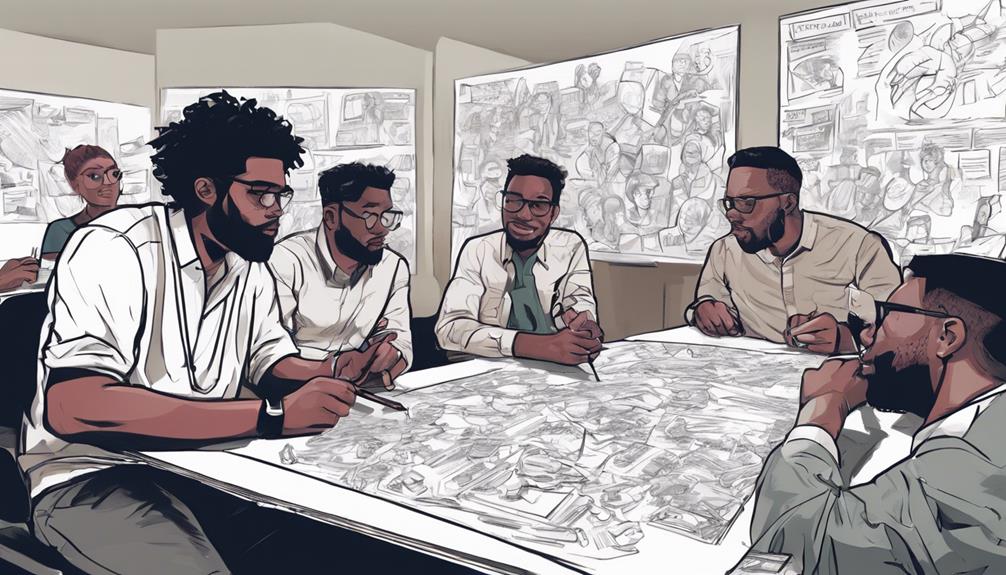
The introduction of the Design Thinking 101 course at HSBC has greatly transformed the organization's approach to innovation and problem-solving. Steve Suarez's initiative to implement this program has had a significant impact, as evidenced by the following:
- Over 5,500 Registrations: The course's popularity is evident from the high number of registrations, showcasing the keen interest employees have in adopting design thinking principles.
- Practical Tips for Immediate Application: By offering practical advice that can be applied right away, the course ensures that participants can quickly implement their learnings in real-world scenarios.
- 1,700 Certificates Awarded: The impressive number of certificates granted indicates a substantial level of engagement and commitment from individuals who've completed the Design Thinking program.
The increasing enrollment in the course suggests a growing recognition of its effectiveness in driving innovation and problem-solving within HSBC.
Through this initiative, design thinking has become a cornerstone of the organization's success, yielding tangible results and fostering a culture of creativity and forward-thinking.
Frequently Asked Questions
What Are the 3 P's of Design Thinking?
The 3 P's of design thinking are People, Process, and Product. People involve understanding user needs. Process includes stages like ideation. Product focuses on creating solutions. These P's form the basis for successful innovation and change.
What Are the 5 Pillars of Design Thinking?
You've got the 5 pillars of design thinking: Empathize, Define, Ideate, Prototype, and Test. Each step guides you through understanding users, crafting solutions, and testing ideas. Embrace this framework for driving innovation and change.
What Are the 3 E's of Design Thinking?
To understand the 3 E's of design thinking, remember empathy, experimentation, and evidence-based decision-making. Dive deep into user needs, foster creativity through prototyping, and rely on data for informed choices. These E's drive innovation successfully.
What Are the 5 Steps of Design Thinking?
To answer your question about the 5 steps of design thinking, you'll want to remember Empathize, Define, Ideate, Prototype, and Test. These steps guide you through understanding users, framing problems, creating ideas, building prototypes, and testing solutions.
Conclusion
To sum up, as a leader in the ever-evolving landscape of design thinking, you must embrace change and foster innovation within your team. By utilizing effective leadership strategies and drawing inspiration from successful case studies, you can navigate through challenges and drive impactful change.
Remember, leadership isn't just about guiding the ship, but also about being the wind that propels it forward towards success.
Design Thinking
Book Review: “The Creative Spark: Unleashing Your Inner Artist”
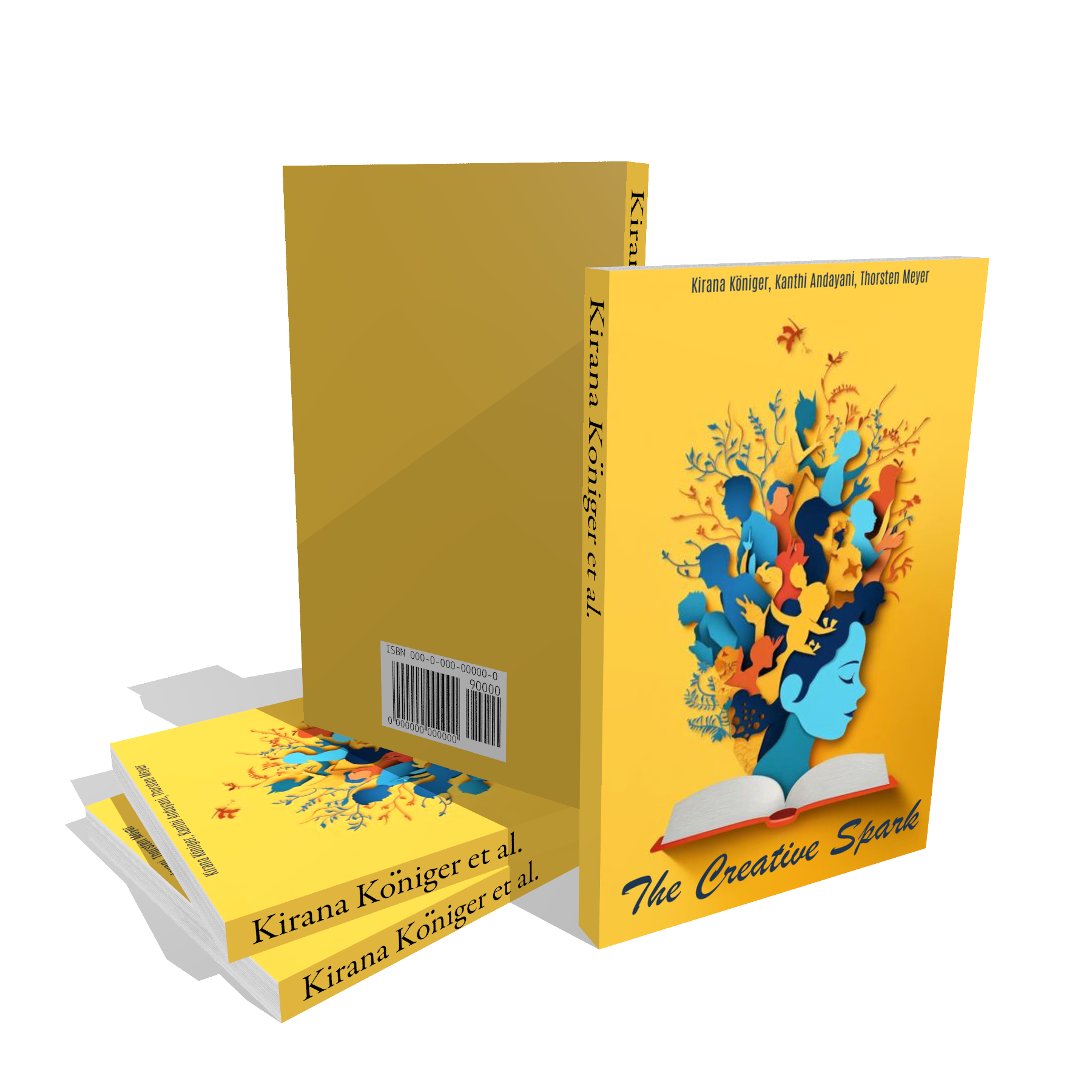
Igniting Creativity in a Digital World
In today’s digital age, where distractions often suppress our natural creativity, “The Creative Spark: Unleashing Your Inner Artist” offers a much-needed remedy. This collaborative effort by Kirana Königer, Kanthi Andayani, and Thorsten Meyer provides a refreshing and multifaceted approach to reigniting the creative spirit.
A Mosaic of Global Creative Wisdom
Cultural Confluence
The authors bring together a wealth of perspectives shaped by their diverse backgrounds, combining Indonesian heritage, European influences, and global experiences. This diversity is not just for show; it forms the foundation of a philosophy that views creativity as a universal language capable of bridging cultural divides.
Harmonizing East and West
By blending Eastern philosophical traditions with Western creative methodologies, the book offers a holistic view of creativity. Readers are presented with a comprehensive toolkit that ranges from mindfulness practices grounded in Asian wisdom to the latest Western psychological theories.
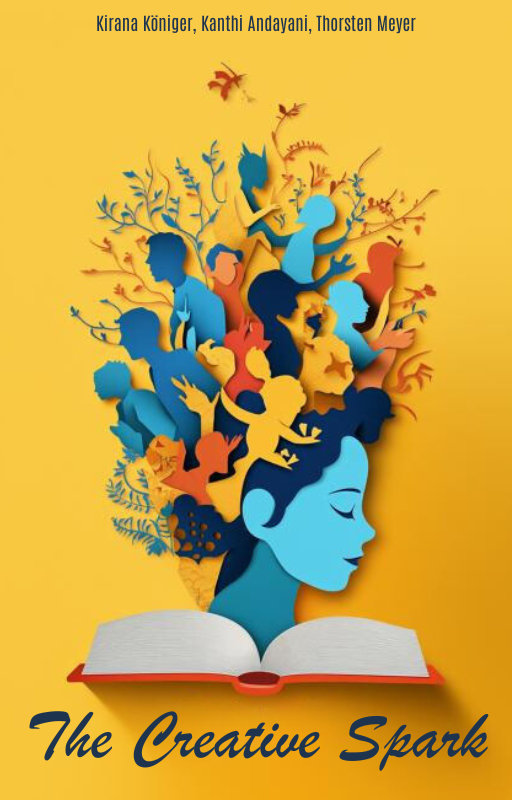
Redefining Creativity for Modern Times
Beyond Artistic Stereotypes
“The Creative Spark” encourages readers to broaden their understanding of creativity, extending it beyond the confines of traditional artistic domains. The authors make a compelling case that creative thinking is an essential life skill, valuable in problem-solving, personal growth, and professional development across all fields.
Creativity in the Everyday
A significant portion of the book is dedicated to uncovering and nurturing creativity in daily life. Readers are guided through practical exercises to:
- Transform routine tasks into creative opportunities
- Enhance observational skills through mindfulness
- Apply creative thinking to personal and professional challenges
- Cultivate a creative mindset that permeates all aspects of life
The Science of Imagination
Neurological Foundations
The book roots its approach in scientific understanding, exploring the brain’s role in creative processes. This section sheds light on:
- How different brain regions contribute to creative thinking
- The impact of neuroplasticity on developing creative skills
- The influence of environment and lifestyle on creative potential
- The link between creativity and overall cognitive health
Psychological Insights
The authors delve into the psychology of creativity, addressing common obstacles such as:
- Overcoming imposter syndrome and self-doubt
- Managing perfectionism and fear of failure
- Building resilience against criticism
- Balancing structure and spontaneity in creative practice
A Toolkit for Creative Growth
Hands-On Creativity
Each chapter offers a variety of exercises designed to stimulate creativity across different mediums:
- Evocative writing prompts for aspiring authors
- Visual art challenges for designers and painters
- Culinary experiments for food enthusiasts
- Mindfulness exercises to enhance creative awareness
- Interdisciplinary projects that blend multiple art forms
Navigating Creative Roadblocks
The section on overcoming creative challenges provides valuable strategies for:
- Breaking through artist’s block and creative stagnation
- Rekindling passion for long-term projects
- Finding inspiration in unexpected places
- Harmonizing creative pursuits with daily responsibilities
Creativity in the Digital Age
Embracing Technology
The book thoughtfully explores the relationship between technology and creativity, discussing:
- The potential of digital tools to enhance creative processes
- Strategies for balancing digital and analog creativity
- Leveraging social media for sharing and promoting creative work
- Ethical considerations in the age of AI-generated art
Sustainable Creativity
In alignment with contemporary concerns, the authors emphasize the importance of sustainable creative practices, encouraging readers to consider the broader impact of their artistic choices.
A Journey of Self-Discovery
Personal Narratives
Throughout the book, the authors share intimate stories from their own creative journeys, adding depth and relatability to the theoretical content.
Reflective Practice
“The Creative Spark” invites readers to embark on a journey of self-discovery through creativity. Thought-provoking questions and journaling prompts help readers:
- Uncover their unique creative strengths and passions
- Explore the connection between creativity and personal identity
- Reflect on how creative expression can catalyze personal growth
Critical Analysis
Strengths
- A comprehensive approach that transcends traditional artistic boundaries
- A rich multicultural perspective offering global insights
- A strong scientific foundation balanced with practical application
- An inclusive tone that makes creativity accessible to all readers
Considerations
- Some readers might find the breadth of topics overwhelming
- Certain cultural references may resonate more strongly with specific audiences
- Advanced practitioners might find some basic concepts familiar, though the book offers fresh perspectives
Conclusion: Sparking a Creative Revolution
“The Creative Spark: Unleashing Your Inner Artist” is more than a guide to becoming more artistic—it’s a roadmap to living a more imaginative and fulfilling life. By presenting creativity as an essential human trait rather than a specialized skill, the authors have crafted a work with the potential to transform how readers approach not just art, but life itself.
Rating: 4.85/5 stars
Highly recommended for its inclusive approach, scientific grounding, and transformative potential. “The Creative Spark” stands out as a comprehensive, insightful, and practical guide to creative living in the modern world, promising to ignite the artistic flame within every reader.
Design Thinking
Cottagecore Home Office: Rustic Charm for Work
Transform your workspace into a serene retreat with a cottagecore-home-office, blending rustic charm with cozy productivity.
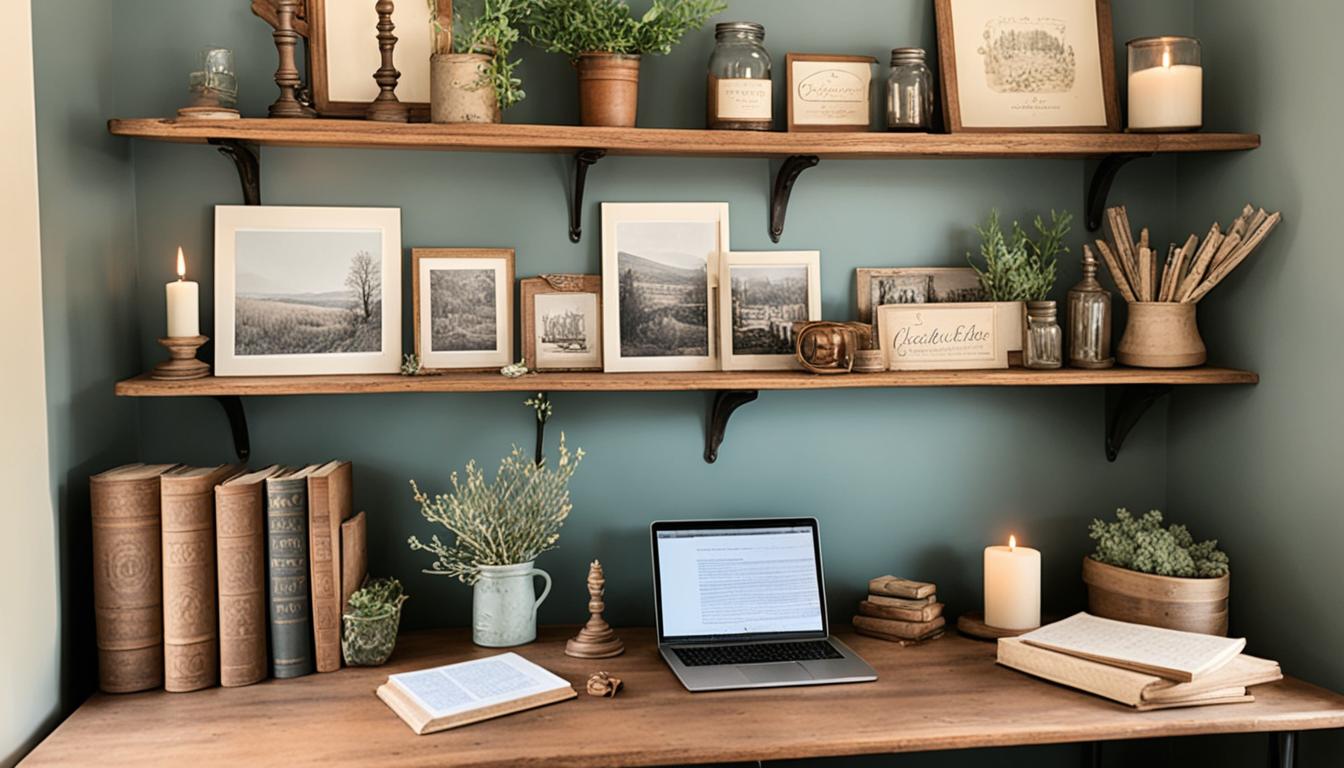
Picture this: you step into your workspace and it’s suddenly more peaceful. The cottagecore home office concept invites you to craft a cozy workspace. It mixes rustic charm with comfort. In our busy world, imagine turning your office into a calm retreat. This style is all about simplicity and nature. Imagine rustic wood, plants, and soft lights. These not only make your space look good but also help you work better. With this beautiful style gaining popularity, let’s make your office a place you love, one detail at a time.
Key Takeaways
- The cottagecore aesthetic blends rustic charm with warmth and simplicity.
- Transforming your office can enhance productivity and creativity.
- Visual elements like botanical decor and soft lighting contribute to a cozy workspace.
- There are various cottagecore desk ideas available on platforms like Pinterest.
- The cottagecore aesthetic appeals to diverse interests, including vintage and nature-inspired designs.
- Integrating personal touches can make your workspace uniquely yours.
Understanding Cottagecore Aesthetic
The cottagecore aesthetic comes from a love for countryside life. It shows a rustic style full of nostalgia. This trend loves vintage looks, like fields of wildflowers and storybook cottages. It connects us to nature. Cottagecore has become super popular in fashion and home design in the last ten years.
- Abundantly beautiful gardens that celebrate simple living.
- Cottage-style interiors filled with organic materials like linen and stone washed cotton.
- Indoor plants and fresh flower bouquets that bring the outdoors inside.
- Mixing modern and vintage elements to create unique, personalized spaces.
- Cozy and layered textiles, including floral patterns, vintage rugs, and comfy quilts.
This style is all about comfort and warmth, reminding us of the English countryside’s charm. It makes us slow down and enjoy life’s beauty. By adding cottagecore to our living spaces, from art to decor, we seek peace and simpler times. Making your space cottagecore friendly makes it welcoming, calm, and full of charm.
Why Choose a Cottagecore Home Office?
A cottagecore office is more than just pretty. It makes working from home comfy and peaceful. This setting is perfect for thinking up new ideas and getting more done. With its nature-inspired look, it’s easy to love your workspace.
Having a cozy space helps you focus and lowers stress. This kind of office lets you work better and enjoy it too. Everything in it is chosen with care, making it feel truly yours and super functional.
Cottagecore lets you mix old treasures and meaningful decor. Each piece tells a story, adding warmth to your day. Natural materials and bold flowers make your office one of a kind, changing how you see work from home.
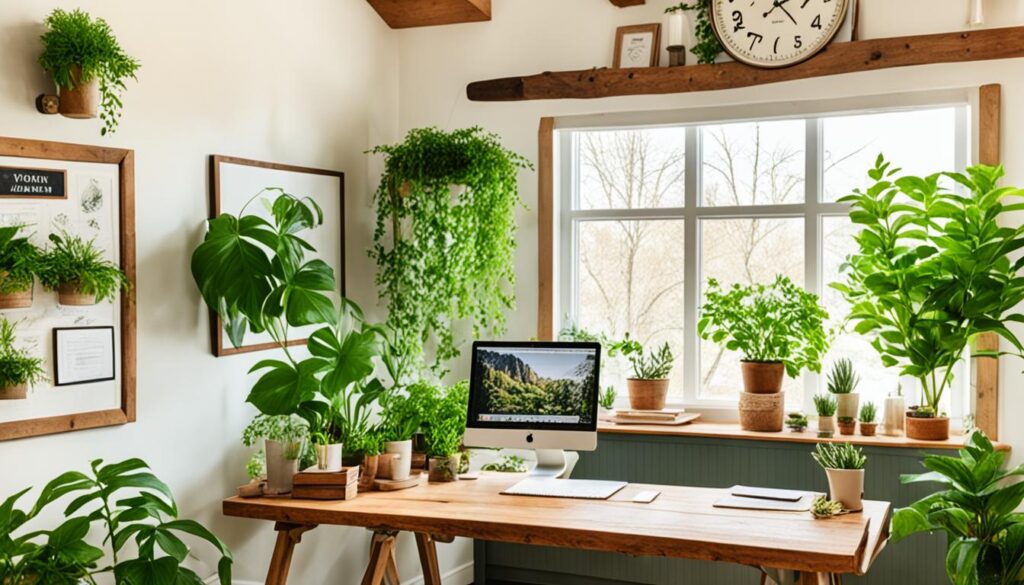
Mixing patterns, colors, and textures makes your office calm and boosts creativity. Slow decorating means taking your time to make it perfect for you. It becomes a personal retreat that shows off what you love.
Choosing this style blends simplicity and work life beautifully. It boosts your work and slows life down a bit. You get a space that helps you work well and reminds you of the joy in simple things.
Creating the Perfect Workspace
Designing the perfect workspace can make your home office both stylish and more productive. Choose cottagecore design to add a rustic, charming vibe.
First, place your desk where it gets lots of natural light. It makes the space feel warm and helps you stay productive. A cozy corner with lots of light, vintage decor, and personal touches can become your writing nook.
Selecting the right furniture is crucial. Hunt for unique pieces at local flea markets or on sites like Craigslist and eBay. Use vintage dressers for both storage and style. They help keep your space tidy and inviting.
- Use wicker baskets and decorative wooden boxes to manage clutter.
- Drape vintage quilts over chairs for a cozy touch.
- Integrate indoor plants, dried flowers, and pottery to enhance the cottagecore theme.
Art is key for that perfect cottagecore look. Mix different frame styles for an eclectic feel. Choose nature prints or old ads. Check out Society 6 or garage sales for great finds.
Choose retro task lamps and Edison bulbs for a warm glow. This lighting invites you into the space, blending style with function. Following these tips, you’ll design a workspace that’s both beautiful and practical.
Incorporating Natural Materials
Using natural materials is key to a cottagecore home office. They add charm and create a peaceful workspace. Try using different materials that make you feel close to nature.
Wooden furniture like desks and shelves made of reclaimed wood are perfect. They add personality and are good for our planet. Stone accents can also bring a nice, grounded feel to your office. And don’t forget about soft fabrics like linen and cotton for a cozy touch.
To finish your cozy office, mix in some vintage items. This gives a nice balance between old and new. Following these ideas will help you make a workspace that’s not just beautiful. It will also make you feel relaxed and inspired.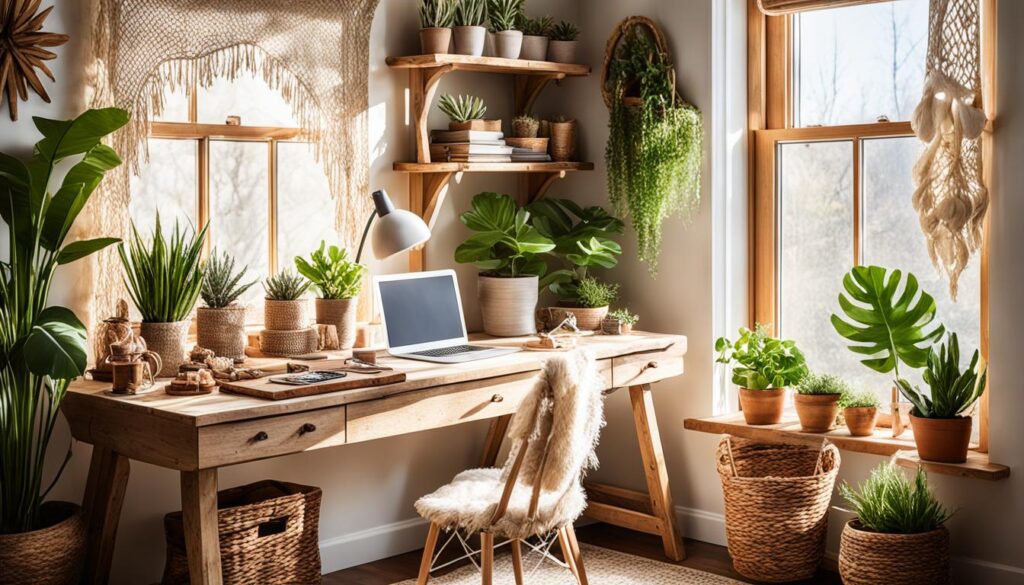
Cozy Furniture Options for Your Cottagecore Home Office
The right furniture can make your cottagecore office cozy and stylish. Look for vintage desks that are not just useful but also charming. They should have a special look or a weathered finish to bring a nostalgic vibe.
For sitting, choose options that make you feel relaxed and ready to work. Think about getting plush chairs or benches with soft cushions. These should be covered in natural materials like linen or cotton. Adding soft, muted colors around them makes your office feel even warmer.
When it comes to storage, go for shelves made of natural wood. They’re useful and fit the cottagecore look perfectly. Use them to display old books and personal knick-knacks. This adds a personal touch and makes your office welcoming.
| Furniture Type | Key Features | Benefits |
|---|---|---|
| Vintage Desks | Intricate designs, weathered finishes | Adds charm, encourages nostalgia |
| Plush Chairs | Soft cushions, natural fabrics | Comfortable seating, inviting ambiance |
| Wood Shelving | Natural materials, practical storage | Organizes space, enhances aesthetics |
Picking the right cottagecore furniture means choosing comfort and style. With the best desks, seating, and shelves, you’ll have a workspace that’s both welcoming and inspiring.
Decorative Elements that Enhance Rustic Charm
Creating a rustic decor in your workspace needs careful choice of decorative bits. These elements are key to making a cozy, quaint look of cottagecore. Use cottagecore accents to add charm and personality to your office.
Pick decor that adds depth and color. Floral prints are important, and they make up 65% of the decor. Adding vintage decorative items brings a nostalgic touch. About 70% of decor ideas include these. Natural materials like wood and plants are 80% of your choices. They give your office an organic vibe.

Textiles play a big role in creating a cottagecore place. About 75% of designs use quilts, curtains, and cushions. These pieces add warmth and comfort. Also, include practical decor like glass-front cabinets and open shelves. These were in 20% of the suggestions. They combine beauty with function.
Choose vintage furniture, as 12 out of 38 options use antique styles. Also, about 45% of decor ideas include handmade or artisanal items for a personal feel. Pastel colors are in 60% of setups. They create a soft, soothing look. Include whimsical or fairytale-like items in 40% of your decor for a magical touch.
Your workspace should be both personal and harmonious. It’s a charming place for creativity. The integration of these charming workspace elements makes your office uniquely cottagecore.
Choosing a Color Palette
Choosing the right colors for your cottagecore home office makes a big difference. Soft shades bring peace and a touch of the old days. Think of gentle pastels like pink and baby blue, plus deeper colors like sage green.
To make your workspace feel just right, mix old-fashioned colors with natural materials. Some top picks are:
- Benjamin Moore Soft Fern: A quiet green that calms.
- Sherwin Williams Rookwood Sash Green: A deep green, great for highlighting walls.
- Behr Silver Celadon: A light celadon that reminds you of classic pottery.
- Farrow and Ball Sudbury Yellow: A cozy yellow, full of character.
Adding wood tones like red cherry or mahogany can make your office feel warmer. The goal is to balance colors so your space is both lively and relaxing. Good lighting with warm colors adds coziness.
Try mixing colors like Stone, Aqua, and Purple. Or go for calmer Blues and Mint. A color wheel at $3.69 helps see how colors work together.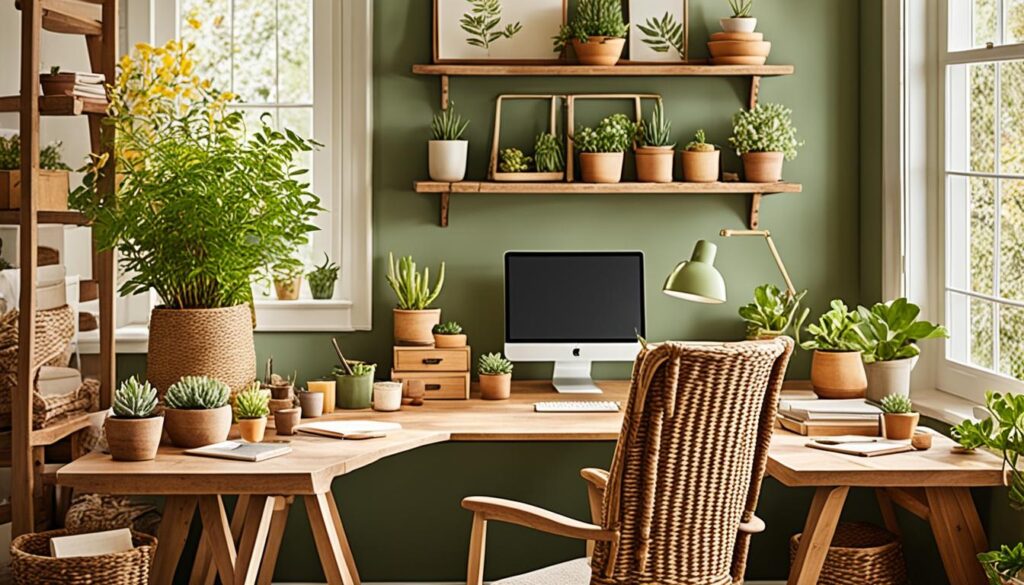
Cottagecore Desk Ideas and Inspirations
Turning your desk area into a cozy spot is exciting, thanks to cottagecore’s charm. Think of adding elements that bring tranquility and spark creativity when looking at cottagecore desk ideas. Aim for a rustic vibe by using various materials and decorations that bring nature indoors.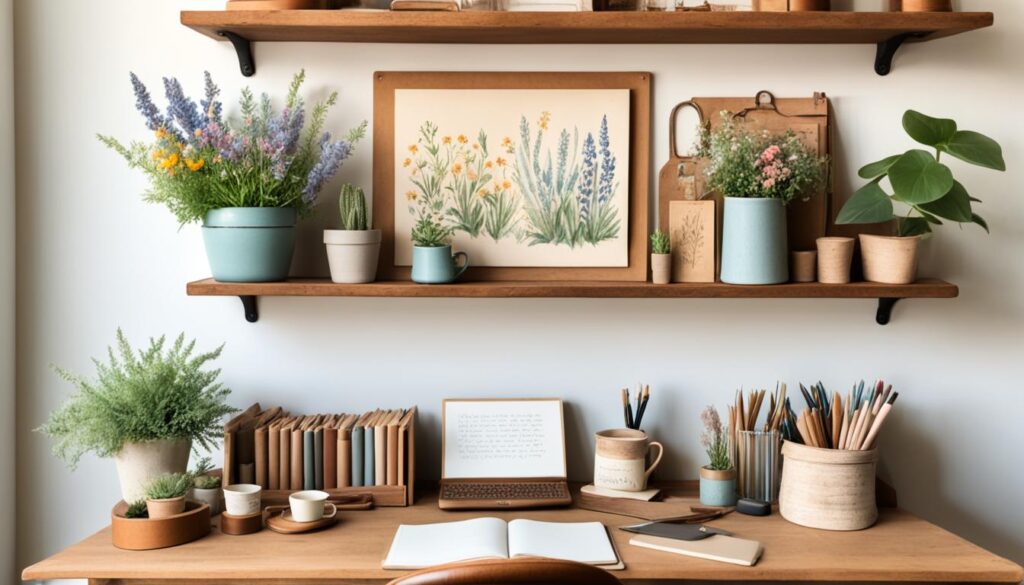
The furniture you pick is key for your workspace. A vintage dining table can be a great desk, full of beautiful details and a romantic feel. Using reclaimed wood adds a rustic flair and also supports sustainability. Just make sure not to crowd your space.
Add accessories like pen holders and paper organizers that fit the cottagecore style. Pick desk lamps in warm tones for good lighting. Grid collages or pin boards are useful for keeping notes tidy and add a cozy feel to your space.
- Consider a desk with built-in drawers for efficient organization.
- Select a chair that complements your desk’s aesthetic, possibly an upholstered piece with floral patterns.
- Invest in high-quality floating shelves for style and extra storage.
- Add neon lights for a modern twist on the rustic charm.
There’s a lot to think about with desks. Wooden desks bring a classic feel, while white desks can make the space look modern and chic. By combining beauty with function, your cottagecore desk area will be both charming and practical.
Balancing Functionality and Comfort in Your Cottagecore Home Office
Creating a perfect workspace means mixing work needs with comfort. In a cottagecore home office, this balance boosts productivity while keeping things peaceful. Think about your work habits. Try arranging your furniture to be both efficient and charming. This is key to the cottagecore look and feel.
Choosing smart solutions is crucial for a good home office. For instance, pick cable organizers that fit your style. They keep your area neat, avoiding mess that ruins the cozy vibe. Also, think about using vintage baskets or stylish shelves for storage. These add function and fashion, making everything you need easy to grab.
Staying comfortable is just as important. Choose ergonomic chairs and desks to prevent soreness. Soft quilts or pillows add to the comfort, making your office feel welcoming. This balance ensures your cottagecore office is both lovely and practical.
To show these concepts, here’s a table. It highlights how functionality and comfort come together in your cottagecore home office:
| Aspect | Functionality | Comfort |
|---|---|---|
| Furniture | Ergonomic desks and chairs | Soft cushions and cozy throws |
| Lighting | Task lighting and adjustable lamps | Battery-operated candles for ambiance |
| Storage | Efficient shelving and hidden drawers | Vintage storage options like baskets |
| Decor | Minimalist approaches with neat arrangements | Hand-stitched quilts and plants |

Making your office fit the cottagecore style can inspire calm and creativity. Mixing practical items with comfy touches does more than boost work output. It also makes your space a soothing spot that helps balance work and life.
The Role of Plants in Your Workspace
Putting plants in office spaces is key for a serene and inviting vibe. They bring beauty and better well-being indoors. Studies show that plants boost creativity, concentration, and refresh the space.
It’s good to choose plants that grow well inside. Succulents, ferns, and flowering plants add beauty and clean the air. They remove harmful toxins and raise humidity, which is good for a healthy office.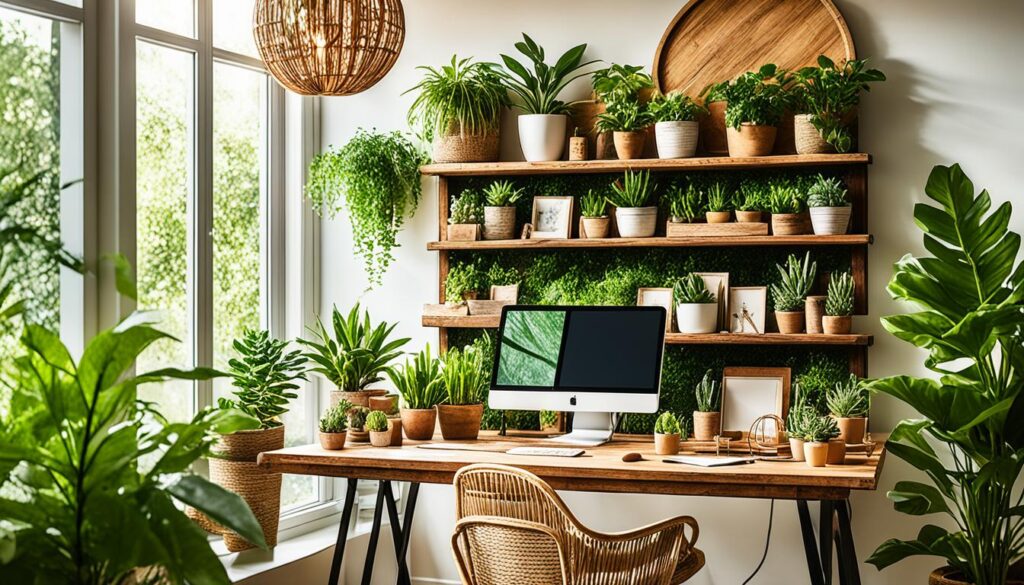
Indoor plants offer a peaceful feeling while you work. They can reduce stress and help you focus better. Imagine working in a space that’s both calm and productive.
There are many plant options to fit your style and enhance wellness. Their presence promotes a positive mood and makes the office more welcoming.
To create a cozy, cottagecore office, mix in dried flowers or personal items with your plants. This adds a unique charm and personal touch. Adding plants to your workspace is more than just decor. It improves your daily work life by encouraging creativity and productivity.
Tips for Organizing Your Cottagecore Home Office
Creating a clutter-free workspace in your cottagecore home office boosts productivity and peace. Use organizing tips that mix function with cottagecore’s rustic charm to improve your space.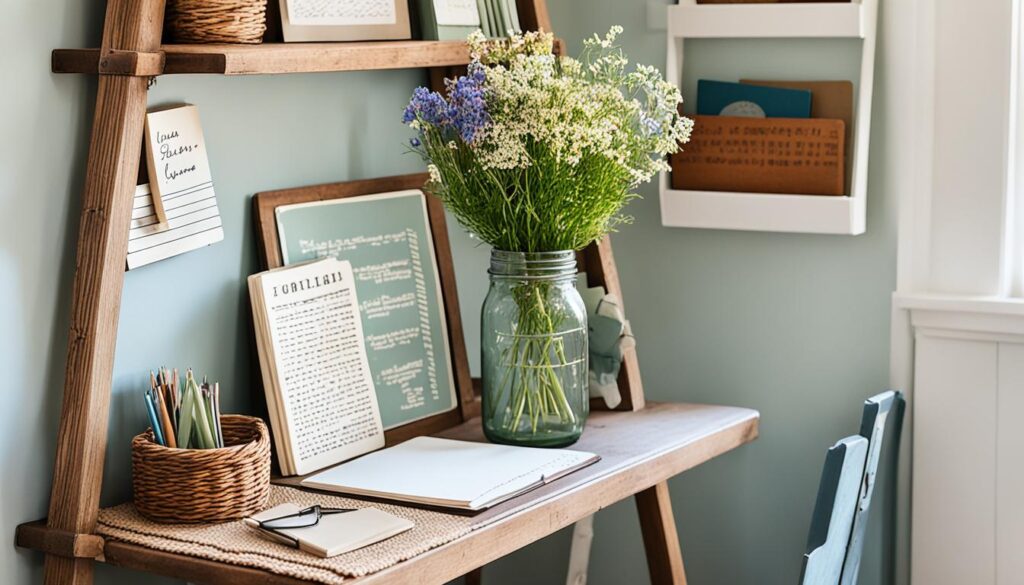
Begin with hidden storage like vintage trunks or decorative baskets. These items blend with your decor and keep supplies out of sight. Keep only inspiring items on display for a workspace that’s both pretty and practical.
Regularly clear out digital clutter as a twist on cottagecore organization. Dedicate weekly time to sort emails and online files. This keeps your digital space as calm as your physical one.
Combine creative storage options, daily cleanup, and digital mindfulness to make a cozy office. This approach boosts both the charm of your space and your work efficiency.
Conclusion
This summary of the cottagecore home office shows how to blend rustic charm with work needs. By using nature, vintage pieces, and personal flair, you can make a space that’s both unique and efficient. Cottagecore’s charm brings peace and balance to your work life.
The heart of cottagecore is to live mindfully. When setting up your space, think about whether you prefer light or dark colors. Add things that make you feel close to nature. Also, think about how you can be eco-friendly every day.
Starting on your cottagecore office is a chance to really connect with your space. Use your senses, be creative, and enjoy the calm it brings. Your office is like an empty painting. Fill it with your style and cottagecore’s magic.
FAQ
What is a cottagecore home office?
How can I enhance productivity in a cottagecore home office?
What types of furniture work best for a cottagecore home office?
What color palette should I use in a cottagecore home office?
How do I incorporate natural materials in my workspace?
How can I decorate my cottagecore home office?
What plants should I add to my cottagecore home office?
How can I maintain organization in my cottagecore home office?
Design Thinking
Small Mistakes, Big Impact: Navigating Life’s Tiny Pitfalls

We all make mistakes, but it’s often the small ones that can have the most significant impact on our lives. In this article, we’ll explore the world of small mistakes, their consequences, and how to learn from them to lead a more fulfilling life. Let’s dive into the fascinating realm of human error and personal growth!
Common Small Mistakes That Can Derail Your Life
Even the tiniest missteps can have far-reaching consequences. Here are some common small mistakes that might be holding you back:
Key Points
- 20% of people identify themselves as chronic procrastinators
- 88% of people don’t have a time management system
- 60% of adults don’t engage in regular physical activity
- 47% of employees avoid discussing issues with their managers
- 55% of Americans don’t have a budget
- 70% of employees are not engaged in their jobs
These seemingly insignificant errors can compound over time, leading to missed opportunities and unfulfilled potential. To learn more about avoiding life’s traps, check out Know Your Best Avoiding Life’s Traps section.
The Psychology Behind Making Small Mistakes
Understanding why we make small mistakes is crucial for personal development. Our cognitive processes, habits, and decision-making patterns all play a role in these minor errors.
Factors Contributing to Small Mistakes
By recognizing these factors, we can work on improving our awareness and decision-making skills. For more insights on personal growth, visit Know Your Best Personal Development and Growth category.
Learning from Small Mistakes
Mistakes are valuable learning opportunities. Here are two books that can help you embrace a growth mindset and learn from your errors:
These resources can help you develop a more positive attitude towards mistakes and use them as stepping stones to success. For more on learning from mistakes, visit Know Your Best Learning from Mistakes tag.
Strategies for Avoiding Common Life Errors
While we can’t eliminate mistakes entirely, we can take steps to reduce their frequency and impact. Here are some practical strategies:
Practice Mindfulness
75% report reduced stress levels
Develop Good Habits
66% report improved self-discipline
Learn from Others
80% report improved problem-solving
Regularly Reflect
90% report improved self-awareness
Implementing these strategies can help you navigate life’s challenges more effectively. For more tips on self-improvement, check out Know Your Best Self-Improvement and Motivation category.
Embracing Imperfection and Continuous Improvement
Remember, making mistakes is a natural part of life. What matters most is how we respond to them and use them as opportunities for growth. Here are two books that can help you on your journey of self-improvement:
Conclusion: Turning Small Mistakes into Big Opportunities
As we’ve explored in this article, small mistakes are an inevitable part of life. However, by understanding their impact, learning from them, and implementing strategies to avoid common pitfalls, we can turn these tiny errors into opportunities
-

 Design Thinking4 months ago
Design Thinking4 months agoThe Design Thinking Venn Diagram Explained!
-

 Design Thinking4 months ago
Design Thinking4 months agoDesign Thinking in Finance: Innovating the Financial Industry!
-

 Design Thinking4 months ago
Design Thinking4 months agoHow IBM Is Pioneering Design Thinking!
-

 Design Thinking4 months ago
Design Thinking4 months agoHow Design Thinking for Social Impact Is Changing the World!
-

 Design Thinking3 months ago
Design Thinking3 months agoSmall Mistakes, Big Impact: Navigating Life’s Tiny Pitfalls
-

 Design Thinking4 months ago
Design Thinking4 months agoMaster the Design Thinking Process Steps in No Time!
-
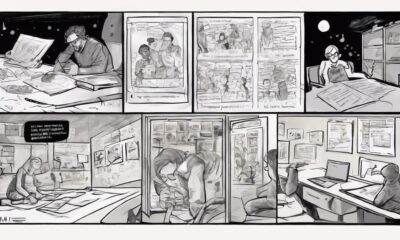
 Design Thinking4 months ago
Design Thinking4 months agoDesign Thinking Storyboard: Visualize Your Ideas!
-
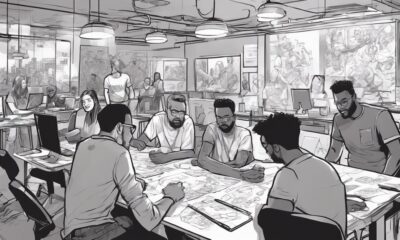
 Design Thinking4 months ago
Design Thinking4 months agoHow IDEO Revolutionized Design Thinking!
